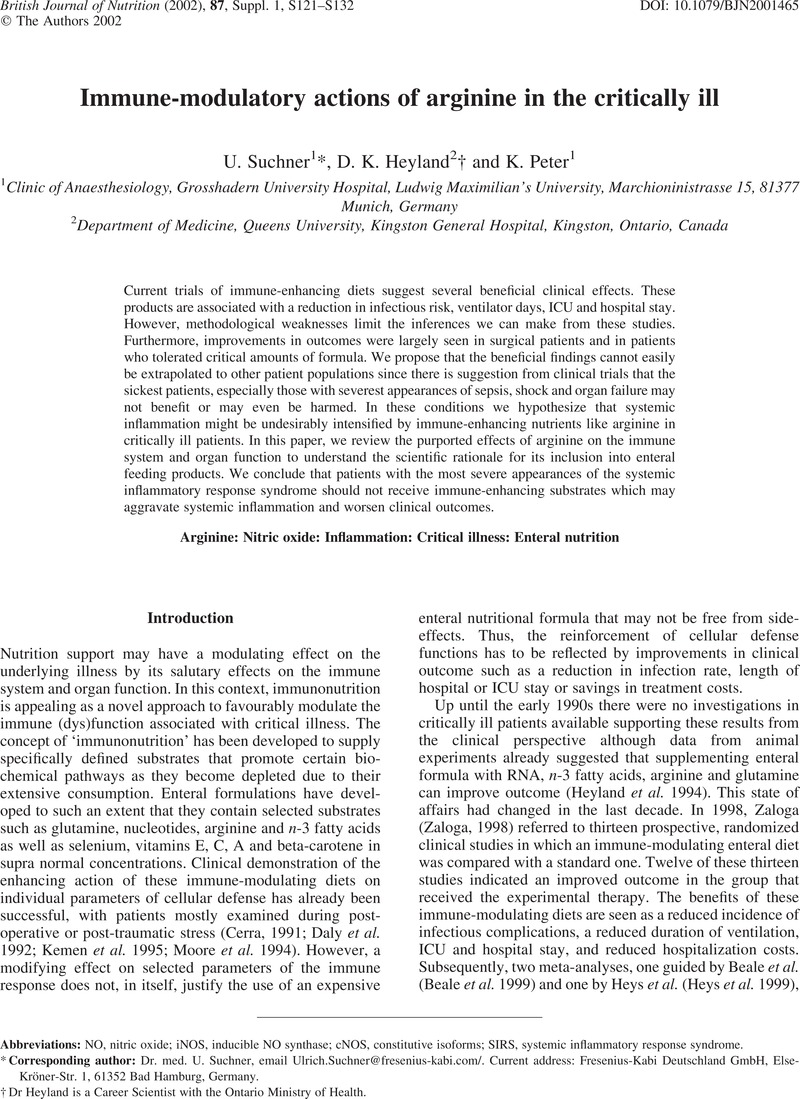Crossref Citations
This article has been cited by the following publications. This list is generated based on data provided by Crossref.
Chioléro, René L
and
Berger, Mette M
2002.
Improving nutritional support in critically Ill septic patients:.
Nutrition,
Vol. 18,
Issue. 9,
p.
723.
Griffiths, Richard D.
2003.
Specialized nutrition support in critically ill patients.
Current Opinion in Critical Care,
Vol. 9,
Issue. 4,
p.
249.
Ziegler, Thomas R.
Evans, Mary E.
Fernández-Estívariz, Concepción
and
Jones, Dean P.
2003.
TROPHIC AND CYTOPROTECTIVE NUTRITION FOR INTESTINAL ADAPTATION, MUCOSAL REPAIR, AND BARRIER FUNCTION.
Annual Review of Nutrition,
Vol. 23,
Issue. 1,
p.
229.
Coster, Jane
McCauley, Rosalie
and
Hall, John
2003.
Role of specific amino acids in nutritional support.
ANZ Journal of Surgery,
Vol. 73,
Issue. 10,
p.
846.
Stein, J.
2003.
Praxishandbuch klinische Ernährung und Infusionstherapie.
p.
484.
Heyland, Daren K.
and
Samis, Andrew
2003.
Does immunonutrition in patients with sepsis do more harm than good?.
Intensive Care Medicine,
Vol. 29,
Issue. 5,
p.
669.
Bertolini, Guido
Iapichino, Gaetano
Radrizzani, Danilo
Facchini, Rebecca
Simini, Bruno
Bruzzone, Paola
Zanforlin, Giancarlo
and
Tognoni, Gianni
2003.
Early enteral immunonutrition in patients with severe sepsis.
Intensive Care Medicine,
Vol. 29,
Issue. 5,
p.
834.
Corke, C.
2003.
Immunonutrition - a proven treatment for perioperative patients or an interesting idea in search of data?.
Critical Care and Resuscitation,
Vol. 5,
Issue. 4,
p.
246.
Kozar, Rosemary A.
Verner-Cole, Elizabeth
Schultz, Stanley G.
Sato, Nario
Bick, Roger J.
DeSoignie, Roland
Poindexter, Brian J.
and
Moore, Frederick A.
2004.
The Immune-Enhancing Enteral Agents Arginine and Glutamine Differentially Modulate Gut Barrier Function following Mesenteric Ischemia/Reperfusion.
The Journal of Trauma: Injury, Infection, and Critical Care,
Vol. 57,
Issue. 6,
p.
1150.
Sukhotnik, Igor
Mogilner, Jorge
Krausz, Michael M.
Lurie, Michael
Hirsh, Mark
Coran, Arnold G.
and
Shiloni, Eitan
2004.
Oral arginine reduces gut mucosal injury caused by lipopolysaccharide endotoxemia in rat.
Journal of Surgical Research,
Vol. 122,
Issue. 2,
p.
256.
Le Floc'h, Nathalie
Melchior, Delphine
and
Obled, Christiane
2004.
Modifications of protein and amino acid metabolism during inflammation and immune system activation.
Livestock Production Science,
Vol. 87,
Issue. 1,
p.
37.
MacFie, J.
2004.
European round table: the use of immunonutrients in the critically ill.
Clinical Nutrition,
Vol. 23,
Issue. 6,
p.
1426.
Luiking, Yvette C.
Poeze, Martijn
Dejong, Cornelis H.
Ramsay, Graham
and
Deutz, Nicolaas E.
2004.
Sepsis: An arginine deficiency state?.
Critical Care Medicine,
Vol. 32,
Issue. 10,
p.
2135.
Wilmore, Douglas
2004.
Enteral and Parenteral Arginine Supplementation to Improve Medical Outcomes in Hospitalized Patients.
The Journal of Nutrition,
Vol. 134,
Issue. 10,
p.
2863S.
Stechmiller, Joyce K.
Childress, Beverly
and
Porter, Tricia
2004.
Arginine Immunonutrition in Critically Ill Patients: A Clinical Dilemma.
American Journal of Critical Care,
Vol. 13,
Issue. 1,
p.
17.
Mizock, Barry A.
and
DeMichele, Stephen J.
2004.
The Acute Respiratory Distress Syndrome: Role of Nutritional Modulation of Inflammation Through Dietary Lipids.
Nutrition in Clinical Practice,
Vol. 19,
Issue. 6,
p.
563.
Sanz, A.
Celaya, S.
Gracia, P.
Gracia, M.L.
and
Albero, R.
2004.
Inmunonutrición.
Endocrinología y Nutrición,
Vol. 51,
Issue. 4,
p.
202.
CARTWRIGHT, M
2004.
The metabolic response to stress: a case of complex nutrition support management.
Critical Care Nursing Clinics of North America,
Vol. 16,
Issue. 4,
p.
467.
Anderson, Beverley
2005.
Nutrition and wound healing: the necessity of assessment.
British Journal of Nursing,
Vol. 14,
Issue. Sup5,
p.
S30.
Jochum, F.
2005.
Infusionstherapie und Diätetik in der Pädiatrie.
p.
153.



